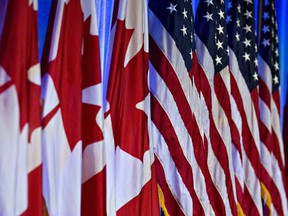If the U.S. lost, they assumed Canada would ask for ‘Alaska be awarded to her,’ notes short-lived 1930s war strategy War Plan Red
Article content
It’s become increasingly evident that U.S. President Donald Trump’s rhetoric about Canada becoming the 51st state isn’t just bluster to achieve a more advantageous trade position.
Article content
Article content
So far at least, he hasn’t mentioned any use of military force to realize territorial expansion and U.S. national security advisor Mike Waltz said he doesn’t think Trump “has any plans to invade Canada,”
Advertisement 2
Article content
But a plan to so do already exists and has for nearly 100 years.
However, War Plan Red, one of several colour-coded war plans devised by U.S. military strategists after the First World War, didn’t identify Canada as a threat. The Yankees’ crosshairs were aimed at the British Empire and the red was a reference to the coats worn by British soldiers during the American Revolutionary War.
Recommended from Editorial
In the plan Canada’s hue is crimson and America’s is blue.
“Geographically, while CRIMSON provides the RED Empire as a whole with advantageous bases at such widely separated points as to invite an initial dispersion of BLUE armed forces, CRIMSON itself occupies an extremely weak position with respect to BLUE,” reads the plan, first developed in 1925, updated in 1935 and declassified in 1974.
“While its territory is of great extent, all well developed parts thereof lie close to the BLUE border; hence, they are especially vulnerable to attack from BLUE.”
Article content
Advertisement 3
Article content
Initially, the strategy also wasn’t developed with annexation in mind but with a “the best defence is a good offence” mentality that would result in incursions and short-term occupations until the larger conflict with the British was resolved, one way or another.
The 1935 update, however, declared that the U.S. would hold any gained territory in Canada “in perpetuity.”
“The policy will be to prepare the provinces and territories of CRIMSON and RED to become states and territories of the BLUE union upon the declaration of peace.”
If the U.S. lost, they assumed Canada would ask for “Alaska be awarded to her” in return for all the hassle.
Thankfully, Canada remains a sovereign nation, but if the Americans did decide to go to war against Britain, here’s how they envisioned it playing out.
U.S. secretly hoped Canada would ally with Britain
Even though they’d been allies toward the end of the First World War, the relationship between the U.S. and Britain remained frosty in the intervening years — due in no small part to the latter’s massive war debt to America.
Further compounding matters was the British Royal Navy which had become the superpower of the sea while American shipbuilding was “in a very depressed state” and years from being revived.
Advertisement 4
Article content
If a war were to break out, the probable cause was assumed to be related to one or both countries interfering with the other’s principal foreign trade relationships or routes.

And because of both nations’ “proved tenacity” in the theatre of war, the planners “concluded that such a war will be one of prolonged duration.”
Planners also assumed Canada would side with King George V and viewed the nation’s neutrality at the outset of any conflict as “always a matter of doubt.”
Although they were aware of Canadians’ differing regional opinions on fealty to their colonial sires, in the event of war, the U.S. felt “local feeling would have little effect and the CRIMSON Provinces would take united action.”
But the truth is, the Americans considered it advantageous to its cause if Canada allied with the British as it would allow the U.S. to deploy “superior man-power in overrunning” parts of its northern neighbour and causing “suffering to the population and widespread destruction and devastation of the country as well as almost total suppression of normal trade and industry.”
Advertisement 5
Article content
At the time, the U.S. estimated the Canadian Corps and its burgeoning air force to consist of about 100,000 soldiers, non-permanent members and reservists. By 1935, it was noted to be over 135,000.
American plan of attack started in Halifax, moved to Montreal and went west from there
Figuring it would take Britain time to secure a proper foothold on this side of the Atlantic and reinforce Canada’s military with troops from the motherland and its various dominions, the U.S. would act swiftly.
Its goal was to separate the allies so as to impede the Brits’ potency and reduce the risk of an attack on U.S. territory.
Halifax and its strategic ice-free port were seen as of critical importance in at the outset of the conflict and the Americans were prepared to send 25,000 army troops by sea to keep it out of British hands.
Contrary to international conventions, the U.S. authorized “the use of chemical warfare, including the use of toxic agents, from the inception of hostilities.”
Even then, they knew it wouldn’t be easy to take Nova Scotia’s capital and failure to do so came with a starker directive.
Advertisement 6
Article content
“If Halifax could not be captured, its denial to RED as a base by means of air and naval operations, should be attempted.”
In a 1935 update, planners identified Moncton and the port city of Saint John, New Brunswick, as secondary targets.
But if they succeeded in taking Halifax, the U.S. would move on to capture Montreal, seize control of the Great Lakes waterways and take the nickel mine in Sudbury “in order to provide a sufficient supply of this most important alloy metal as well as to deny this supply to RED.”
Provided things went to plan, the rest of the strategy involved eliminating the rail network in Winnipeg and eventually going after naval interests in the Vancouver area.
It was later discovered that in 1935, the U.S. constructed three military airfields adjacent to the Canadian border and labelled them as civilian airports. When the ruse was revealed and Canada officials were understandably miffed, President Franklin Roosevelt needed to state unequivocally that the U.S. had no intentions of going to war with Canada.
What happened to War Plan Red?
In his scholarly study of War Plan Red, University of Hull historian John Major said it was placed in low priority in May 1936 — because a growing threat in Japan, or Orange in colour parlance, was taking precedence.
“The following October it was officially declared obsolete by the Chief of Staff, with the directive that no action be taken towards its revision or replacement.”
A scant eight years later, all three nations were allies in fighting Germany and its spreading fascism.
Today, the document can be found in storage at the National Archives in College Park, MD.
Our website is the place for the latest breaking news, exclusive scoops, longreads and provocative commentary. Please bookmark nationalpost.com and sign up for our daily newsletter, Posted, here.
Article content








